SCALES- Scales are made up of 7 notes and are often referred to as the key of the song. The 7 keys in a scale tell us what we can play that sound good together, if we go off key it often sounds bad. Scales are very important for an in depth understanding of music. If you play guitar you may be familiar with a pentatonic scale, given away from the name this is a scale which includes five notes. Which are notes 1, 2 ,3 , 5 and 6 of the scale. A pentatonic scale is very useful for making melodies as nothing can sound bad if you stick to the scale.

OCATAVES- An octave is a group of 8 notes that each have a different frequency and sound unique to each other. There are many octaves on a piano that each share octaves of the same arrangement of frequencies, the distinct difference between octaves is the change in frequency between them.

TIME SIGNATURE
A time signature is very important as it tells us the pattern of playing. Are we measuring in quavers? how long is each bar? A 4/4 time signature is used in 90% of songs you hear today in pop music, it is more catchy and has a dance pattern. The waltz is usually in the time signature 3/4, this gives it that iconic 1, 2, 3 dance pattern. To examine a time signature the 3/4, the top number of the time sig tells us how many beats in a bar. In this case it is 3 beats. The bottom number tells us what note type we a counting in, in this case we are counting in crotchets.

KEY SIGNATURE
A key signature is a symbol which is used as reference to tell you what sharps or flats are used in the piece, the number of sharps and flats can tell you what key you are in, if you understand the circle of fifths. The notes which we are told as flat or sharp remain that way unless we are shown a natural symbol before the note. This will tell us to play the natural version of that note.

CLEFFS
A clef is used to segregate notes by pitch, each clef has a different way of reading the notes. This means you need to learn how to read the notes on both the treble (high pitch) clef and the bass (low pitch) clef. Most instruments only work in the bass or treble clefs. However the viola works in the alto clef, which is represented as a ‘B’. The clef has it’s own way of reading notes, the gap between the two circles in ‘B’ tells us where middle C is. From there we can work out the rest by counting up and down.

NOTES
The note symbol tells us how long we play it for, this is used to give the piece rhythm. A semi-breathe is held down for the whole bar in the time signature 4/4.
semi breathe – 4 beats
minim – 2 beats
crotchet – 1 beat
quaver – 1/2 beat
semi quaver- 1/4 note

CIRCLE OF FIFTHS
The circle of fifths is a useful short cut to finding out scales and the sharps of flats inside them. It is also used to find good sounding chord progression and the relative minor of majors. The note ‘C’ is at the top of the circle as it is the center of attention. The circle is split into 2 sides the sharp and flat side. The outside of the circle is all major scales. The order of sharp major scales is (G, D, A, E, B, F#). This can be memorized in the phrase ‘Good dogs are expensive but fun’. To find out the other side of the scale we use the phrase again but backwards. So the flat scales on the left from top to bottom go (F, Bb, Eb, Ab, Db, Gb). Every scale except for C major has sharps. To figure out how many sharps and what the sharps are we use another phrase. From G major to F# major we add one more sharp to the scale as we go down. The sharps add in this order (F#, C#, G#, D#, A#, E#, B#). To find out the flats for the flat side we use the same notes as the sharp side but we use them backwards. So the flat notes from top to bottom on the left would be (Bb, Eb, Ab, Db, Gb, Cb, F).
From here we have figured out all the major scales and the sharp or flat notes in them. However each scale has a relative minor, which is a minor scale which contains the same notes as a major scale. A minor scale is different to it’s relative major because the notes are applied in a different order. To figure out a major scales relative minor we travel down 3 semi-tones from the scales root note. For example from C major we would go down 3 semitones. (B, Bb, A). This means the relative minor of C major is A minor. This means A minor has the same notes, meaning it also contains no sharps or flats.
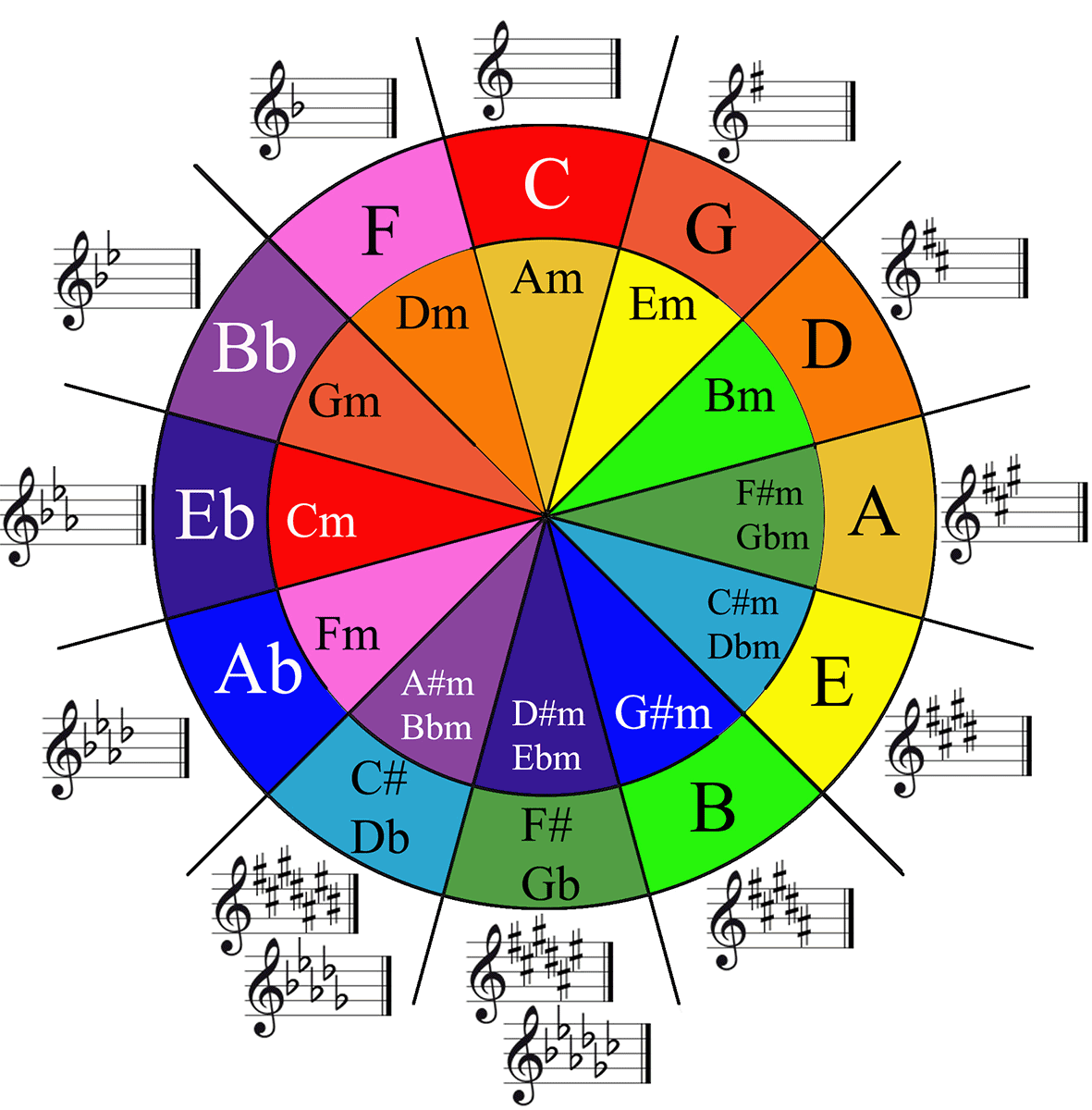
If we were to compose a piece we now have the notes of all major and minor scales, all we need now is to find our chords and progression. To find what chords we can use, we will first write out all notes in the scale. To make this easier I will use the C major scale. (C, D, E, F, G, A, B, C). To find out each chord we will go from the root of the chord we are using and skip every other note twice. So for the first chord in the scale ‘C’, we will go ‘C, E, G’. This means our first chord is C major. To find out if a chord is major we use the formula (1,5, 7), the numbers refer to incline in semi-tones from the root. For minor we use the formula (1,4,7) if it fits it’s minor. To label the chords we use the roman numerals system, we use uppercase letters if it’s a major chord and lower case if it’s a minor chord.

INVERSIONS
An inversion is a way of re-arranging the notes in a chord but playing the same notes. When the notes are played in a different arrangement we call it an inversion. Triad chords (3 notes) only have 2 inversions. The natural form of there chord is referred to as the root position. For the chord C major this would be (C, E, G). To invert this chord to inversion 1 we would move the ‘C’ to the top of the chord. This would make The order of the chord (E, G, C). To get from the 1st inversion to the 2nd we would move the ‘E’ to the top of the chord. This would make the 2nd inversion (G, C, E). If we inverted that again we would go back to the root position.
C – ——E —— G —— C
E ——-G —— C —— E
G ——C —— E —— G

VOICE LEADING
Voice leading is when you make the transition from one chord to another as smooth as possible by making the notes stay in a similar arrangement to the other chord. This makes the chord change soft. Each example of voice leading is an inversion of a chord, meaning a different arrangement of notes. To show an example of voice leading I will transition C major to F major to D minor before and after voice leading.
C F D C C D
E A F E F F
G C A G A A
INTERVALS
The cycle ion fifths gets it’s name because the notes are made up of 5 note intervals in the C scale. An interval is the distance between the notes in the scale, for example the in the C major scale the interval between D and G is 2 notes. If you play the chords in the circle following the 5 tonic intervals, your ear will want the chords to return to the root chord, so continuing around the circle creates a never resting atmosphere. If you go anti-clockwise through the circle you will find that the circle moves in the note intervals. Each interval in a scale has it’s own name here they are demonstrated below in the C major scale. There was a famous jazz musician in the 1950’s called John Coltrane, he had Buddhist beliefs and liked the idea of an equilateral triangle. He decided he wanted to implement this into his work, so he drew a equilateral triangle on the circle go fifths and made a chord progression out of them. Obviously some would be out of key, so he changed the chords to fit in the scale but also sound simply.
C- ROOT TONIC
D- MAJOR 2ND
E- MAJOR 3RD
F- PERFECT 4TH
G- PERFECT 5TH
A- MAJOR 6TH
B- MAJOR 7TH
C- 8VE
SHEET MUSIC SYMBOLS
LEDGER LINES- A ledger line is pretty much a custom stave line we draw on after we have gone out of the pitch range of the regular clef staves. We draw on ledger lines on so that we can work out what note we are meant to play by using the lines as reference to usual stave lines. Middle C is always on a stave line in sheet music.

Ties- A tie is represented as a curved line that connects to two notes of the same pitch. To work out a tie it involves a bit of maths as the two notes connected by a tie have to be played as one note, but with the length of them both. So if we see a minim in the middle of a bar tied to another minim at the beginning of the next bar, we have to literally add two and two together because minims play for two beats. This means the tie in this example must be played for four beats.
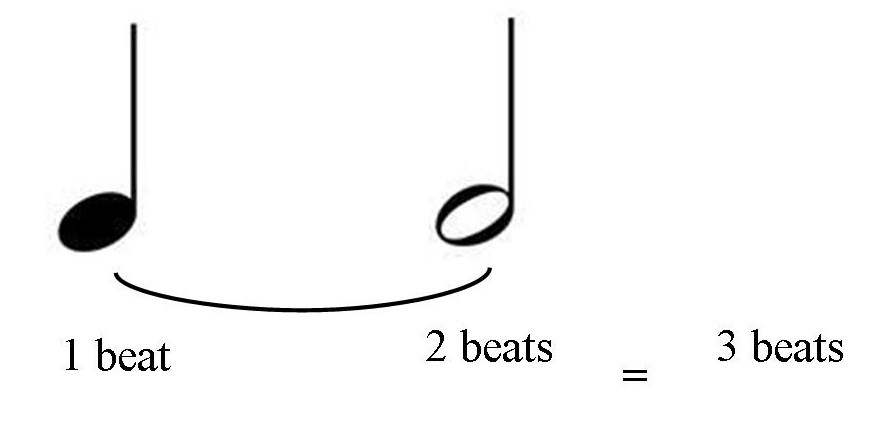
Slurs- A slur looks very very similar to a tie, however it is easy to tell the difference. This is because a tie has to be connected to a note of the same pitch and a slur does not. A slur tells us to play the notes within the start to the end of the slur in a legato flow (smooth flowing), this means we can’t have an interrupted silence between the notes. We play legato by not letting go of the current note we were playing until we have started to press down the next note, this will leave no interrupted silence between notes.
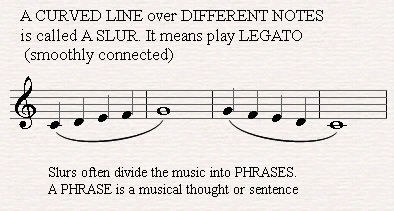
Pedal markings- A piano has two main pedals the sustain pedal and the damper pedal. The sustain pedal makes the notes ring out for a longer duration of time, it does this by moving all the dampers away from the strings. The damper pedal makes the notes shorter, it does this by putting the damper against the piano strings as soon as you release the note to stop it from ringing out. If you see the word ‘PED’ below the bass clef stave lined it is telling you to press down the sustain pedal, the line after the word PED represents how long you hold it down for. You will release the pedal and hold it down again when you see a spike in the line which means you have to press it down again. After a while of following the line you might see the word ‘simile’ which is the Italian word for same, this means the composer wants us to repeat the pedal pattern. If it does not say this word and instead has a dead end line we have to stop. We might just see a symbol similar to a snow flake which means we have to release the pedal.

Tempo mark- In modern day music a tempo will mostly be measured in BPM (beats per minuet). The music will tell us this above the key signature, and will tell us what tempo to play at, it uses the crotchet symbol as a reference to beats, because as we know one crotchet is equal to one beat. However in music you may also see words that you can’t make sense of such as ‘moderato’ next to the tempo mark, this is because these words are Italian. If you read classical sheet music you will see this often as they measured tempo through words and not BPM. I will list a translation of these words now; Adagio (slow), Andante (walking pace), Moderato (quite quick), Allegro (fast), Presto (very fast).

Dynamic symbols- Dynamic symbols will be seen multiple times in musical pieces, these symbols will often be seen as letters, symbols or full words. The symbols will be placed between the staves and will tell you what the want you to do with the dynamics. The words of the dynamics originate from the Italian language and have been adopted world wide and are used today. FUN FACT, the full name of the piano is actually ‘Piano Forte’ which translates to quite loud. This is because of the dynamical range of the piano. Letter markings are simple because they tell you when to play ‘piano’ or ‘mezzo forte (medium loud)’.
Crescendo and diminuendo markings are a tiny bit more advanced, they are represented in a similar way to the symbol for ‘Smaller than’ in a maths equation. The beginning of the marking tells you when you have to start getting louder and as the symbol opens up wider you have to play louder, by the end of the symbol you must be playing at a fortissimo ‘very loud’ volume. The diminuendo symbol is represented by a backwards crescendo symbol, you might see these a lot at outros and endings of songs as it represents a fade in dynamics, by the end of the diminuendo you have to be playing at a piano ‘soft’ volume.

sharps, naturals and flats- On sheet music one of the first things you will have to look at is the key signature which will you can read to see what key it’s in. You will either see no symbols at all which means it is in the key of C major or A minor. You might see some hashtags which represent sharp notes, this means you will have to play the note that the sharp is on as a sharp the whole way through the piece, unless their is a natural sign which I will explain soon. If you see a little ‘b’ you are playing in a flat key and all them notes the ‘b’ is on must be played as a flat, unless their is a natural sign in the piece. A natural sign tells us to play the notes in their natural form, which means we will be playing the white note of it as a one off. The natural sign can be seen below.
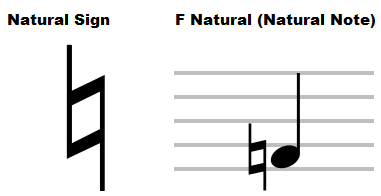
Notes
If you are a beginner learning notes the first thing you want to get familiar with is the pattern of the keys. The note C is placed next to the left of the 2 black keys. In ascending order from the note C it goes; D, E, F, G, A, B. We go to the begging of the alphabet after G because there are only 7 notes in a scale. If we play notes to the right of C we will ascend in pitch, if we play notes to the left of the C we will descend in pitch.
After we know the basic white notes we can start to learn what sharps and flats are. A sharp key will always be to the left of the white note we are basing it on and example of this would be #F. We would use the natural F as a reference to find it’s # version. We would move to the black key right of it to find the note ‘#F’. To find a flat note it is the exact opposite, we instead will move left of the natural note to find it’s flat version. I will use the note G as an example, to find it’s flat note we will move left of it to find it’s flat, the name of this note will be called G flat. Sharps and flats are represented by the black keys on the piano there are 5 black keys in an octave, and what we call these black keys refers to the note and scale we are playing in. If we are playing in a sharp scale we will only refer to these keys as sharps such as ‘#G’. If we are playing in a flat scale we will only refer to the black keys as flats such as ‘bD’. For example let’s say we are in the key of G major which has one sharp which is #F, because we are working in a sharp scale we will not call this note G flat. Even though these notes are the same we will only decide it’s name depending on what scale we are in.
READING NOTES ON SHEET MUSIC
Reading notes on sheet music is one of the hardest things to get hold of in music, it learning to read all over again. But with a simple introduction you can learn how to read sheet music. First of all staves and ledger lines rely on the concept of gaps and lines to find notes, every note will either be in a gap between a stave or ledger line or on one. We want to use middle C as our main reference point, which is the C in the middle octave of a piano. First lets learn how to read treble clef notes, to work this out lets find middle C. Middle C is on the first ledger line below the stave bottom stave. To work out the other notes we need to know the C major scale which is (C, D, E, F, G, A, B, C). Each step we take in ascending order will follow the notes in the C major scale as we hop in between the stave lines and on them. If we want to descend in pitch we will have go down the scale in reverse as we draw the notes on the lines and in between our ledger lines.

The bass clef is a similar way of thinking but middle C is on the ledger line above the bass’s top clef. It’s the same concept if we want to descend in pitch we will have to go down the staves in the reverse C major scale, and if we are going up from the bass’s middle C we are going forward in the C major scale.

CHORDS
A chord is when you play multiple notes together which creates harmony between them. Every song you listen to has a chord progression, which is a sequence of chords that make up a song to structure it. Different chords have different tones that create certain emotions, major chords have a happy and energetic tone to them. But minor chords can create moods of fear, sadness and darkness. Minor chords are used a lot in scary movie soundtracks and tense movie scenes, major chords are used a lot in happy scenes and dance songs. Sometimes when song writing you don’t want to play the chord in one movement, this is when you can use an arpeggio. An arpeggio is a chord that is played in individual notes, although it is not played as one whole chord if all the notes of the chord are played it still counts. Arpeggios are used to add rhythm to a song or composition.
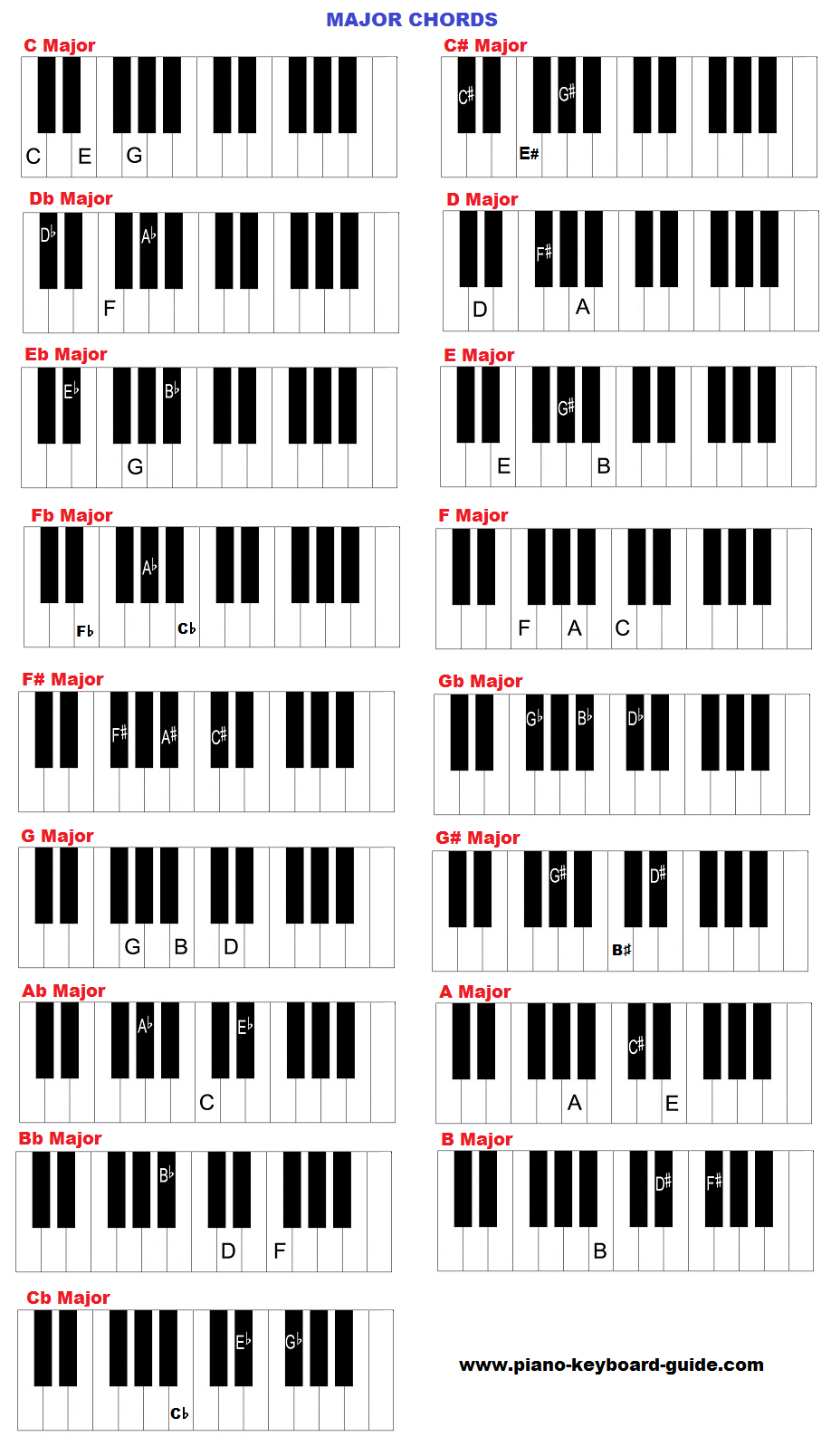
FINDING THE KEY
If you want to quickly find the key a song is in without reading all of the sharps and flats their is an easy technique. If the key signature is written in flats you need read the last flat that is written in the key signature, this will tell you what key the song is in. For sharps all you need to do is go up one note from the last sharp in the key signature to get the name of the key it is in.